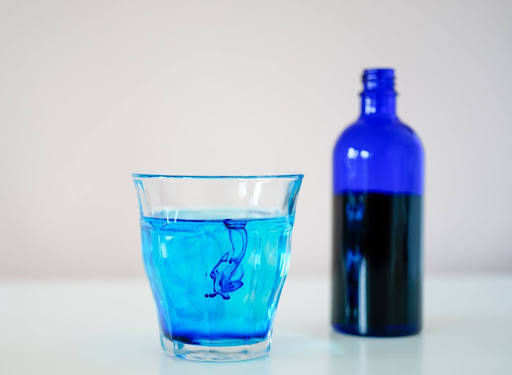Methylene blue is gaining a lot of attention in health and wellness circles today. You’ve probably seen it listed on menus at cutting-edge health centers and functional medicine clinics. It’s also a favorite topic among many wellness experts, biohackers, beauty industry leaders, and even professional athletes who praise it for supporting focus, increasing energy, enhancing skin health, boosting immunity, and speeding recovery.
It might seem like a new wellness trend, but methylene blue is actually a “not-so-new” medical breakthrough. It is a well-established compound with a long history in medicine dating back to the late 1800s, even making history as one of the first fully synthetic medicines used in humans.
What’s new is the type of attention it’s getting today. Practitioners are turning to methylene blue as a modern tool for healing and wellness, while researchers are taking a closer look at how it works at a cellular level, specifically how it supports the mitochondria, the power plants of our cells.
In this article, we’ll explore the fascinating history of methylene blue and its emerging role in modern longevity and functional medicine. You’ll learn how this unique compound is believed to work inside your cells to support mitochondrial cellular energy production, the common uses it has today, and what current science says about its potential benefits for brain health, energy, healing, healthy aging, and more.
History and Origins of Methylene Blue
Methylene blue didn’t start as the popular wellness compound it is today. In fact, it didn’t begin as a medication at all. You will understand more about the safety of methylene blue as you read, so don’t let this alarm you, but it was actually first used as a dye.
Textile Dye
In 1876, German chemist Heinrich Caro synthesized methylene blue to meet demands in the booming textile industry for vibrant and stable synthetic dyes. At that time, natural dyes were often unreliable or faded quickly, so synthetic options like methylene blue were groundbreaking.
Biological Stain
Not long after its creation as a dye, German physician Paul Ehrlich discovered something interesting. The young researcher saw that methylene blue could selectively stain bacteria and cell structures.
This breakthrough gave scientists a powerful new way to see microbes and details inside cells under a microscope, advancing microbiology and medical research, and quickly establishing methylene blue as a widely used biological stain.
Malaria Treatment
A few years later, interest in methylene blue grew beyond staining after researchers observed that it interacted with certain microorganisms in ways that could be therapeutically useful.
Specifically, chemists found that methylene blue effectively marked parasites. This led to experiments testing its effectiveness against malaria, which at that time was a serious health issue worldwide, especially in tropical and subtropical regions.
In the early twentieth century, methylene blue was administered for malaria treatment and prophylaxis. During World War II, some military units used methylene blue when supplies of quinine, the standard malaria drug, were limited.
Although newer and more effective antimalarial medications eventually replaced it, methylene blue holds a place in medical history as one of the first fully synthetic medicines used in humans.
Expanding Medical Use
Over the years, additional medical benefits of methylene blue were discovered. Clinicians learned that methylene blue could restore hemoglobin’s ability to carry oxygen, which is crucial for supplying tissues with life-sustaining oxygen.
This insight led to its use as an antidote for acquired methemoglobinemia, a blood disorder where hemoglobin is oxidized and can no longer transport oxygen efficiently. This remains its only FDA-approved prescription use today.
Surgeons also adopted methylene blue as a helpful dye for identifying specific tissues during surgery. For example, it is used to locate sentinel lymph nodes in cancer surgeries or identify parathyroid glands during thyroid operations.
In more specialized medical settings, methylene blue has been explored as a treatment option for rare conditions, such as ifosfamide-related encephalopathy (a brain disorder caused by a chemotherapy drug), and as an adjunct therapy in vasoplegic or distributive shock, conditions involving dangerously low blood pressure after surgery or severe infection.
The Focus Today
Today, modern scientists are building on centuries of knowledge about methylene blue and reexamining exactly how it works inside living human cells.
They’re looking deeper into methylene blue’s effects on the mitochondria, the tiny structures in your cells that are responsible for producing energy needed for nearly every bodily function, including brain activity, immune system function, hormone production, muscle movement, vascular health, regulation of cell death and growth, and more.
Understanding how methylene blue supports mitochondrial function could open new possibilities in treating many processes that rely on steady cellular energy. Their primary areas of focus to date are studying how the mitochondrial support methylene blue is believed to provide could ___ such as:
- Brain function and cognition
- Neurogenerative disease
- Mood disorders
- Injury and wound healing
- Exercise performance and recovery
- Chronic fatigue
- Vascular health
- Skin health/anti-aging
- ++ More
We’ll explore these developments a little further down. First, let’s discuss the connection between methylene blue and cellular energy production, so you have a better understanding of its potential in supporting overall health and vitality.
How Methylene Blue Works at a Cellular Level to Support Mitochondria and Cellular Energy Production
Methylene blue’s health benefits are believed to start deep inside your cells, specifically at the mitochondria. These tiny structures, often called the “power plants” of your cells, are responsible for producing adenosine triphosphate (ATP), the primary energy source your body relies on for all your body’s systems to work correctly and to keep cells healthy over time.
When mitochondria function well, and a steady supply of ATP is maintained, your cells have the cellular energy needed for everything from thinking and healing to muscle movement. In contrast, poor mitochondrial function can lead to many health issues, including fatigue, slower recovery, and even contribute to the aging process.
You can support mitochondrial health through many basics, such as a nutrient-rich diet, regular exercise, quality sleep, stress management, and proper hydration. However, methylene blue is believed to potentially play a more direct role in cellular energy production by supporting the function of the mitochondria themselves, specifically during the cellular respiration process, which we’ll discuss next.
Simply put, methylene blue shows potential in helping keep this crucial step in the energy production process running smoothly so your cells can generate energy more efficiently, and allow you to feel and function your best.
How Methylene Blue Works in the Body to Support the Cellular Respiration Process and ATP Production
Inside mitochondria, energy production happens through cellular respiration, the process that converts nutrients and oxygen into usable energy.
A key part of this process is called the electron transport chain. This chain moves electrons along a series of proteins inside the mitochondria, creating the conditions for most of your cells’ ATP to be generated. Essentially, it is during this part of the cellular respiration process that mitochondria produce most of the ATP your cells use.
When the chain functions smoothly, mitochondria can produce cellular energy efficiently. But if the process slows down or becomes damaged, it can cause a buildup of reactive oxygen species (ROS), which are harmful molecules that create oxidative stress. Oxidative stress damages cellular components like DNA, proteins, and fats, contributing to aging and various diseases.
Early research suggests that methylene blue may help reduce this stress by lowering ROS levels. This could help decrease cellular damage, support cellular health, and potentially contribute to healthier aging.
But more importantly, methylene blue is being studied for its role as an electron cycler, meaning it can accept and donate electrons. This unique property may help bypass inefficiencies in the electron transport chain, restore smoother electron flow, and support mitochondria in producing ATP more effectively.
By reinforcing this fundamental process, methylene blue shows potential in helping cells maintain healthy energy levels, which may support overall cellular performance and resilience.
What This Could Mean for Your Overall Health and Vitality
The health and function of your mitochondria are crucial for providing cellular energy that fuels nearly every process in the body.
These tiny structures create the ATP needed for healthy brain function, muscle movement, hormone production, immune defense, and even cell renewal, especially stem cells, which play a central role in tissue repair and regeneration. Without a steady supply of energy, none of these systems can perform at their best.
Supporting mitochondrial health is always a good idea, but it becomes especially important when energy demands are high or when natural function begins to decline. This can happen with aging, chronic stress, poor sleep, nutrient deficiencies, toxin exposure, or certain medical conditions that impair cellular energy metabolism.
In these situations, mitochondria may struggle to keep up with the body’s needs, leaving cells more vulnerable to fatigue, slower recovery, and oxidative damage. This is where methylene blue is being explored.
The science is still evolving, and more human studies are needed to fully understand the impact methylene blue might have on improving long-term health, as well as more specific functions that rely heavily on mitochondrial energy.
Potential Benefits of Methylene Blue in Modern Medicine
In modern medicine, interest in methylene blue has expanded beyond its established roles in treating acquired methemoglobinemia and serving as a surgical dye.
Many trials have only used animal models and/or are still in the pre-clinical phase, but scientists are actively studying how methylene blue interacts with mitochondria and cellular energy pathways to better understand whether it could potentially be used to support brain health, mood, physical performance, skin vitality, healthy aging, and more.
Areas of emerging research include:
Brain Function and Memory
Because the brain requires large amounts of energy to function, researchers are exploring whether methylene blue can support memory and focus by making mitochondrial energy production more efficient.
Early clinical trials suggest it may influence brain activity patterns and improve certain types of memory, but larger human studies are still needed. To learn more, read “How Methylene Blue Supports Cognitive Health.”
Neurodegenerative Disease
Methylene blue is also being studied as a potential adjunct therapy in neurodegenerative conditions like Alzheimer’s disease. Its ability to cross the blood-brain barrier, its antioxidant properties that can mitigate oxidative stress and inflammation within the brain, and its effects on the central nervous system are thought to play a role.
Methylene blue’s ability to disrupt the formation of amyloid plaques is another reason researchers are exploring it as a candidate in Alzheimer’s research. Small randomized clinical trials investigating its potential benefits in treating Alzheimer’s show promise, but more research is needed. Small animal studies also show promise for other neurodegenerative diseases such as Parkinson’s and multiple sclerosis (MS).
Mood Disorders
Research suggests mitochondrial dysfunction can be a contributing factor to mood disorders such as depression, anxiety, and bipolar disorder. Researchers theorize that methylene blue may help by boosting cellular energy production in the brain, acting as a reversible monoamine oxidase inhibitor (MAOI), and providing neuroprotective benefits.
A key factor is its ability to cross the blood-brain barrier and directly influence brain cells. There have been a few small human studies, but most research thus far has been in small animal studies and is still preliminary. Large-scale, rigorous human trials are needed to confirm these findings and establish proper dosing.
Energy and Fatigue
Because mitochondria generate the ATP that powers every system in your body, researchers are exploring whether methylene blue could help reduce chronic fatigue and support overall energy.
Early studies demonstrate that methylene blue can enhance mitochondrial efficiency, acting as an electron carrier that supports ATP production. Medical reviews also suggest it may help maintain energy levels and improve stamina by aiding cellular energy creation.
Most of this research remains preliminary, primarily in lab models or early human observations. Larger, controlled clinical trials are needed to confirm whether methylene blue can reliably improve fatigue and energy in people. To learn more, read “The Energy-Boosting Benefits of Methylene Blue.”
Exercise Performance and Recovery
Exercise places high demands on mitochondria. Researchers are investigating whether methylene blue can help improve recovery and performance by enhancing cellular energy production.
Many athletes praise these effects and early findings point to its potential to help cells meet higher energy demands; however, this also remains an area of ongoing study rather than an established benefit.
Cellular Aging and Longevity
Oxidative stress drives cellular aging, the gradual decline in how well your cells function. This could impact anything from skin vitality to memory, energy, and resilience.
Methylene blue’s antioxidant effects and ability to support mitochondria make it of particular interest in longevity research. Laboratory studies show it may lower reactive oxygen species and help protect cells, but whether this translates into meaningful anti-aging effects in humans is still uncertain.
Skin Health and Renewal
Skin cells depend on healthy mitochondria to renew themselves and maintain resilience. When mitochondrial function declines, skin can lose elasticity, hydration, and firmness, contributing to visible signs of aging.
Early research suggests methylene blue may help counter this by reducing oxidative stress in skin cells and supporting collagen production. In laboratory studies, methylene blue applied to skin fibroblasts improved thickness and delayed cellular aging compared to other antioxidants.
While these findings are promising, larger human studies are needed before methylene blue can be confirmed as a reliable option for skin vitality or cosmetic aging. To learn more, read “The Role of Methylene Blue in Anti-Aging Medicine: Why It’s Getting Attention.”
Injury, Surgery, and Wound Recovery
Researchers are studying whether methylene blue can support recovery from injuries, surgical procedures, and chronic wounds. Early laboratory studies suggest it may help skin cells repair more efficiently, and small clinical trials using methylene blue in photodynamic therapy have reported improvements in healing chronic ulcers and reducing infection.
There is also preclinical evidence that it may help limit postsurgical scar tissue formation. While these findings are promising, larger human trials are needed before methylene blue can be considered a reliable therapy for wound or surgical recovery.
Vascular Health
Researchers are also exploring methylene blue for its effects on blood vessels and circulation. Early studies suggest it may help restore vascular tone and support blood pressure in cases of severe low blood pressure, such as after cardiac surgery or during septic shock. While results are encouraging, larger clinical trials are needed before methylene blue can be considered a reliable option in this area.
Immunity and Inflammation
Methylene blue is being studied for its potential to influence immune and inflammatory pathways. Laboratory research shows it may help reduce certain signals that drive excessive inflammation, which has sparked interest in its possible role in immune support. At this stage, these findings are still preliminary, and more human studies are needed.
Antiviral Activity
Laboratory studies suggest that methylene blue may have the ability to inactivate certain viruses, including influenza and coronaviruses, under controlled conditions. These results are intriguing, but so far they have not been confirmed in living systems or human trials. More research is needed to determine whether methylene blue could have a meaningful antiviral role.
Common Uses of Methylene Blue
While the science continues to develop in these areas and more, many people are already turning to methylene blue as part of their wellness routines.
Based on what is currently understood about how it influences mitochondria, many modern functional health clinics and centers offer guided methylene blue therapy as part of personalized protocols for energy, clarity, and longevity support.
Common reasons people seek methylene blue include:
- Supporting energy levels and reducing fatigue
- Acceleration of wound, injury, or surgical recovery
- Supporting immune resilience and defense against infection and illness
- Cognitive enhancement, such as mental clarity, memory, and focus
- Improving skin health and supporting healthy aging processes
- Enhancing physical stamina and recovery after exercise
- Promoting mood balance and emotional well-being
- As complementary support in broader wellness and longevity strategies
Despite many people reporting positive personal experiences in these areas, it is important to remember that these are unverified wellness uses of methylene blue that are still being studied. To date, treating acquired methemoglobinemia is the sole FDA-approved therapeutic use of methylene blue. It is also used in other medical applications as a diagnostic dye.
Beyond that, all we know from research thus far is that methylene blue’s effects on mitochondria and oxidative stress provide a strong scientific foundation for the growing interest it is receiving in both medical and wellness communities.
Final Thoughts
From its early use as a biological stain that advanced microbiology, making history as one of the first fully synthetic medicines in humans, then becoming FDA-approved for acquired methemoglobinemia, and now its developing role in modern medicine as a potential supporter of mitochondrial health, methylene blue has earned a reputation as both a historic and forward-looking compound.
While larger and more rigorous human trials are still needed to determine who might benefit most from methylene blue, at what dose, and under what conditions, research is promising, and people who use it through guided therapies in qualified wellness centers, such as intravenous delivery, often report more energy, better focus, and quicker recovery.
It is important to note that this type of care is very different from methylene blue sold online in supplement form, which is often not regulated in the same way and may vary widely in quality, safety, and effectiveness.
If you want to learn more about how methylene blue could potentially support your energy, focus, or overall vitality, schedule a consultation at a Relive Health location near you. Our centers offer a variety of modern personal health treatment options and medical aesthetics designed to help improve your health, longevity, vitality, and appearance to help you look and feel your best.




